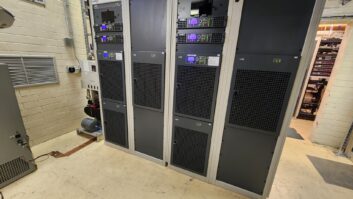Considerations for Elevated IBOC Sidebands
Aug 1, 2008 12:00 PM, By Tim Anderson, CSRE

Figure 1. Transmitter derating for common amplification. Click image to enlarge.
Many questions are being asked regarding the widely reported efforts to increase the current standard one percent FM IBOC injection levels to 10 percent of the unmodulated FM carrier power. Station engineers are seeking guidance as they plan and design transmitter installations for today’s one percent IBOC injection levels while protecting their investment if a power increase is authorized.
The first difficulty in accommodating increased IBOC sideband levels is that, because of the higher (up to 6dB) peak-to-average (PAR) AM component of the IBOC carriers, the transmitter must be derated from Class C saturated FM operation. The more the digital-to-analog carrier ratio is increased, the more the transmitter must be derated. In digital-only operation, the PAR is increased even further, but without the linearizing effect of the constant envelope analog FM signal, the maximum available TPO is further reduced. At the same time that the PAR is increasing, power output of the amplifier is also increasing and the RF intermodulation products must remain suppressed at the same level (74.4dB below the unmoduated FM carrier) as operation at one percent IBOC sideband injection. This means the transmitter linearity must improve by 1dB for every 1dB of increase in IBOC injection by the combined ratio of those increases to maintain NRSC mask compliance. Figures 1 and 2 illustrate the derating required for low-level combined and IBOC-only amplification modes. The tube amplifier derating curve is noticeably steeper than solid-state transmitters. This is because tube amplifiers must be run further into Class AB operation to achieve necessary linearity.
In determining the derating, measurements were made with a minimum of 3dB of headroom below the NRSC RF mask of -74.4dBc with the FM carrier modulated by a 1kHz monaural tone. A true RMS responding, calorimetric power meter was used to measure the total integrated power of the combined analog and digital RF components.

Figure 2. Transmitter derating for separate amplification. Click image to enlarge.
These derating figures are based on HD Radio MP1 mode. It should be noted that as the mode is changed from to MP2, MP3 or MP11 we must further derate the transmitter due to increasing spectral bandwidth density that increases the peak-to-average power of the IBOC sidebands. Figure 3 shows the derating necessary for MP11 versus increased IBOC sideband injection. At -20dBc, MP11 requires approximately six percent derating over MP1 and an additional seven percent (13 percent total) at -10dBc. MP3 requires derating of about half this figure.
The common method
Common amplification can remain a viable combining method for stations with a licensed TPO of 7kW or less using solid-state transmitters, and up to about 16kW licensed TPO using tube transmitters. In these cases, adding a second amplifier cabinet can achieve -10dBc and offers a straightforward upgrade path based on currently available technology. Higher power levels may be achieved at lower injection ratios.
Referring to Figure 4 (page 6), a station with a licensed analog TPO of 7kW, running IBOC at -20dBc using common amplification with a solid-state transmitter capable of 8kW combined power, would be able to increase IBOC injection to -10dBc by adding a second matching amplifier and a 3dB combiner for a maximum combined TPO of 8.5kW and an analog maximum of 7.6kW. At -14dBc, an analog TPO of 10kW is possible. For a station with a licensed analog TPO of 20kW running -20dBc of common amplification with a tube transmitter, adding a matching second amplifier through a 3dB combiner would only deliver a maximum analog power of 16.4kW. This would not enable the station to achieve -10dBc at full power. At -12dBc however, this configuration would be capable of about 23kW of analog power.

Figure 3. Output power reduces as digital injection increases Click image to enlarge.
High-level combining, using separate amplification, becomes exponentially more inefficient to implement as the digital-to-analog ratio increases and is virtually impossible above 6kW licensed TPO at the -10dBc (10 percent) digital injection level. For a 5kW station running a high-level combined system using a 10dB combiner at -10dBc to produce the necessary 500W of digital signal, a 5,000W digital transmitter would be required as 90 percent of the digital power and 10 percent of the analog power must be rejected. A combined total of 5,500W would be sent to the reject load. The highest practical TPO currently available for a solid-state digital-only transmitter is 6kW. Tube transmitters are not optimal for IBOC-only operation because of the lowered efficiency at high PAR amplification. It is apparent that high-level combining is not practical in terms of capital expense or operating efficiency for higher power levels and significantly increased digital injection. However, this method of combining will likely remain a viable option for lower TPO requirements or at something less than -10dBc injection levels.
Space combining � using separate amplifiers and antennas for analog and digital � remains the most efficient and cost-effective method of combining digital and analog signals, particularly at higher power levels and higher digital injection ratios. For a 20kW ERP station to run IBOC at -10dBc, a 2,000W (after line losses) digital-only transmitter and a two-bay (gain of 1) antenna are the only requirements. Isolation between the analog and digital antennas must be increased by 10dB to 40dB of isolation, for -10dB IBOC operation. A ferrite circulator may be required to provide sufficient isolation between the digital and analog transmitters, which can be expensive, particularly at high power levels.
ZX500413 409 4 413 406 7 380 370 10 355 341 14 293 274 18 240 216 24 ZX1000825 817 8 825 812 13 760 741 19 710 682 28 585 548 37 480 432 48 ZX35002800 2772 28 2800 2756 44 2579 2515 65 2410 2314 96 1985 1860 125 1629 1466 163 ZX50004125 4084 41 4125 4060 65 3800 3705 95 6550 3409 141 2925 2740 185 2400 2160 240 Z12HD+6000 5940 60 5325 5241 84 4650 4553 117 3875 3817 158 3503 3282 221 3195 2876 320 Z16HD+8000 7920 80 7100 6987 113 6200 6044 156 5300 5089 211 4670 4375 295 4260 3834 426 Z32HD+16000 15840 160 14200 13975 225 12400 12089 311 13600 10178 422 9340 8751 589 8520 7668 852 HT/HD+25000 24750 250 21700 21356 344 18600 18133 467 14300 13731 569 12300 11524 776 9100 8190 910
Figure 4. Comparison of transmitter power deratings for some Harris transmitters at various digital injection levels.
High-level combined stations currently operating at -20dBc will be able to use their existing digital transmitter for space combining as it is already operating at -10dBc with 90 percent of the power being sent to the reject load. Space combining is not without drawbacks. By regulation, the digital antenna must be within 70 percent of the analog antenna’s height and within three seconds latitude/longitude of the main antenna. The gain and pattern of the digital antenna must be carefully matched to avoid inter-modulation effects and minimize ratio variances in the field. Various antenna manufacturers have dual feed and inter-leaved antenna systems that promise to handle the increased digital power and provide adequate isolation.
Split-Level or mid-level combining becomes a more difficult technique to implement because as sideband levels increase, the significantly higher PAR demands more of the transmitter’s available power leaving very little analog power for the added efficiency gained by the split-level technique. There is still much research to be done in determining how viable SLC might be. Either way, it appears this is still better than high-level combining at lower injection levels of -18dBc or less.
ZX500200 198 196 194 183 171 ZX1000400 396 392 388 366 342 ZX35001400 1386 1372 1358 1281 1197 ZX50002000 1980 1960 1940 1830 1710 Z12HD+2600 2550 2408 2355 2310 2250 Z16HD+3500 3400 3210 3140 3080 3000 Z32HD+7000 6800 6420 6280 6160 6000
Figure 5. Digital-only power levels for some Harris transmitters.
For the most part, simply adding a second digital transmitter will, at the very least, support injection levels of -12 to -14dBc and in many scenarios, will make -10dBc. There will be tradeoffs as to what lengths one will be willing to go in order to make the full -10dBc level. It seems obvious that current combiner technology does not easily support the demands of increased digital levels. As sideband powers are increased, efficiency becomes a much larger concern. The inefficiencies of any of the high-level combining schemes make them unlikely candidates for significantly increased sideband levels. It is likely that antenna space combining will become a popular method of deployment due to its efficiency, particularly for high power installations.
Anderson is the FM/digital radio product line manager for Harris, Cincinnati.











